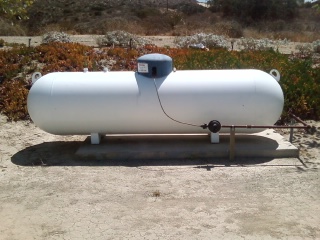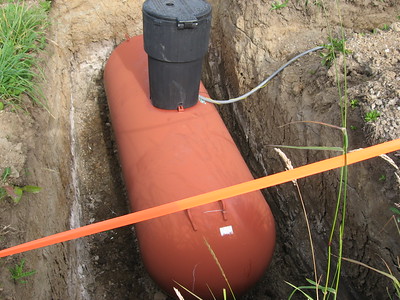Are Underground Propane Tanks Safer Than Above Ground?


There are a few things to consider when deciding whether an underground or above-ground propane tank is right for you. The most important factor is safety. Above-ground tanks are more susceptible to leaks and explosions because they are exposed to the elements. Thus, these are regulated.
Both underground and above-ground propane tanks have safety measures in place and are designed to store propane safely. However, there are differences in the potential risks and safety concerns associated with each type of tank. Here’s a comparison:
Underground Propane Tanks
- Protection from External Threats: Being buried, underground tanks are less susceptible to the dangers of fires, explosions, or physical damage from vehicles or falling objects.
- Aesthetics: Being out of sight, underground tanks do not obstruct views or negatively impact landscaping. This can be seen as a non-safety benefit but may also prevent potential tampering.
- Limited Exposure to Temperature Extremes: Being underground can help moderate temperature extremes, which can influence the pressure inside the tank.
- Corrosion Concerns: Underground tanks have a higher risk of corrosion due to being in contact with soil. However, modern underground tanks are designed with anti-corrosion measures, such as special coatings and sacrificial anode bags, to combat this.
Above Ground Propane Tanks
- Easier Inspection and Maintenance: Above-ground tanks are easier to inspect for potential issues, and any maintenance or repairs can be more easily addressed than with an underground tank.
- Potential External Threats: Being exposed, these tanks are more susceptible to physical damages, fires, or other external threats. They can also be a target for vandalism.
- Temperature Exposure: Above-ground tanks are more exposed to temperature variations, which can influence the pressure inside the tank.
- No Corrosion from Soil: These tanks are not in contact with soil, so they don’t have the same underground corrosion concerns. They can, however, still corrode due to other environmental factors like rain or humidity.
In terms of safety from external threats like fires or physical damage, underground propane tanks might be considered safer. However, both types of tanks come with their own sets of considerations and potential risks. Proper installation, regular inspection, and maintenance are key to ensuring the safety of any propane tank, regardless of its location.
Understanding Propane Tanks
Propane tanks are storage vessels designed to contain propane, a type of liquefied petroleum gas (LPG). These tanks are engineered from high-strength materials (usually steel and sometimes composite materials) and are built to withstand high pressures, as propane becomes a liquid under relatively low pressure. The tanks are typically fitted with valves and regulators to manage the release of propane when it’s needed.
Breakdown of the types of propane tanks (above-ground and underground)
There are two primary types of propane tanks based on their installation location: above-ground and underground tanks.
- Above-ground propane tanks: These are installed on the surface level and are visibly exposed. They come in various sizes, ranging from smaller tanks often used for grilling to larger tanks that can heat a home or commercial premises.
- Underground propane tanks: These tanks are buried below the ground level, with only their access hatches and vent pipes visible. Like above-ground tanks, these also come in various sizes and capacities.
Propane tanks store propane in its liquid form. When the valve on the tank is opened, the propane gas vaporizes and exits the tank through the pressure regulator. This regulator ensures the propane is released at a safe and consistent pressure. When the propane leaves the tank, it’s in a usable form as a gas.
As propane is used, the vapor space within the tank increases. With an adequate propane liquid level, the pressure within the tank will remain consistent. If the level of propane gets too low, the pressure could decrease, impacting the performance of propane-powered appliances.
common uses of propane
Propane is a versatile fuel with numerous applications. It’s commonly used in homes for heating, cooking, and powering appliances like water heaters and clothes dryers. It’s also used for grilling, powering certain types of vehicles, and in various industrial applications. In rural areas where natural gas lines may not be available, propane often serves as a vital source of energy. Other uses include powering generators, forklifts, and farm irrigation engines.
Above-ground Propane Tanks
Above-ground propane tanks are installed and sit visibly on the ground surface. They are typically made from high-strength steel and are equipped with pressure-relief devices for safety. The tanks are often painted with a reflective color to minimize the absorption of solar heat and are installed on stable, well-drained surfaces. The tanks vary in size, ranging from small 20-pound cylinders used for barbecue grills to larger 500-gallon or even 1,000-gallon tanks used for heating large buildings or operating high-energy appliances.
Pros and cons of above-ground propane tanks
- Accessibility for inspection and maintenance: One of the primary advantages of above-ground propane tanks is their accessibility. Being situated above ground allows for easy monitoring, inspection, and maintenance. The tank can be quickly examined for potential leaks, corrosion, or other damage, and necessary repairs can be conducted promptly.
- Lower initial cost: Above-ground tanks are generally cheaper to install compared to their underground counterparts. The installation process for above-ground tanks is less complicated, requiring less time, labor, and no excavation.
- Vulnerability to weather conditions and physical damage: The downside to above-ground tanks is their exposure to weather conditions and potential physical damage. They can be impacted by severe weather such as high winds or heavy snowfall. In addition, their visible nature makes them more susceptible to accidental impact damage from vehicles or vandalism.
Safety measures associated with above-ground propane tanks
Despite the potential vulnerabilities, there are several safety measures in place for above-ground propane tanks. The tanks are engineered to withstand high internal pressures and are equipped with pressure relief valves that release propane if the pressure becomes too high. They are constructed to be impact-resistant and are painted with reflective paint to minimize heat absorption.
Regulations also require that propane tanks be installed a certain distance away from buildings and property lines to minimize potential hazards in the event of a leak or fire. Regular inspections and maintenance by qualified professionals are also part of the safety protocol for propane tank ownership, ensuring early detection and repair of any potential issues.
It’s also worth noting that propane itself has a strong odor added to help detect leaks, and it won’t ignite unless the air concentration is between 2.2 and 9.6 percent, reducing the risk of accidental fires.
Underground Propane Tanks
Underground propane tanks are buried beneath the surface of the ground, with only their dome or access hatch visible above ground. The dome covers the valves and regulators and protects them from the elements. These tanks are designed with a protective coating or made of materials that can resist corrosion. Like above-ground tanks, they come in various sizes, typically ranging from 500 to 1,000 gallons, but can be larger for commercial use.
Pros and cons of underground propane tanks
- Protection from weather conditions and physical impacts: Being buried underground offers a natural protective barrier against the weather and physical impacts. This positioning shields the tanks from severe weather conditions and accidental damage due to impacts from vehicles or other physical activities.
- Aesthetic advantages: For homeowners or businesses concerned about the appearance of their property, underground tanks offer a distinct advantage. Only a small portion of the tank is visible above ground, allowing for landscaping and other aesthetic improvements to be maintained without obstruction.
- Potential corrosion concerns: While underground tanks are designed to resist corrosion, there’s an increased risk compared to above-ground tanks due to their contact with soil and groundwater. Over time, corrosion can cause leaks, making regular inspection and maintenance crucial.
- Cost and complexity of installation: The installation process of an underground tank is more complex and expensive than an above-ground tank. It involves excavation, ensuring the proper protective measures against corrosion, and adherence to various safety regulations.
Safety measures associated with underground propane tanks
To mitigate potential risks, several safety measures are implemented with underground propane tanks. They are often installed with a sacrificial anode bag, which corrodes over time instead of the tank, providing an extra layer of protection against corrosion. The tanks also have a special protective coating to resist corrosion.
The location for installation must be carefully chosen to minimize the risk of water pooling around the tank, which can lead to corrosion and structural issues. Periodic inspections are performed to check for any signs of leaks or corrosion and to replace the sacrificial anodes as needed. The propane in the tank has a strong odorant added, which helps in identifying leaks quickly. Lastly, like above-ground tanks, they are equipped with pressure relief valves to prevent excessive pressure buildup.
Comparing the Safety of Above-ground and Underground Propane Tanks
| Aspect | Above-ground Propane Tanks | Underground Propane Tanks |
|---|---|---|
| Vulnerability to Physical Impact | High due to visible exposure, can be hit by vehicles or damaged due to vandalism. | Low due to burial underground, protected from most physical impacts. |
| Vulnerability to Weather Conditions | High due to exposure to elements, could be affected by high winds, snowfall, etc. | Low as they’re protected from weather conditions being underground. |
| Corrosion Concerns | Lower, as they are fully exposed and do not come into contact with soil or groundwater. | Higher, as they are in contact with soil and potential groundwater, despite protective measures. |
| Accessibility for Inspection and Maintenance | High, as they are easily accessible for regular inspection and maintenance. | Lower, as underground position can make inspection and maintenance more challenging. |
| Cost and Installation Complexity | Lower initial cost and installation complexity. | Higher initial cost and installation complexity due to excavation and protective measures. |
| Aesthetic Impact | High, as they can be seen openly and may impact property aesthetics. | Low, as they are buried and don’t affect property aesthetics. |
| Safety Measures | Pressure relief valves, mandatory distance from buildings and property lines, regular inspections. | Pressure relief valves, protective coatings, sacrificial anodes for corrosion prevention, proper location choice to prevent water pooling, regular inspections. |
Why might people choose to have an underground propane tank?
There are several reasons that people might choose to have an underground propane tank rather than an above-ground one. One reason is that underground tanks are less likely to be damaged in a storm or by high winds. Another reason is that they are less likely to be vandalized.
Underground tanks are also less likely to leak because they are buried in the ground and the soil provides extra support.
Are there any benefits to having an underground propane tank?
Underground propane tanks are often thought to be safer than above-ground tanks, as they are less likely to be involved in an accident or spill. In addition, underground tanks are less likely to be damaged by severe weather conditions.
However, there are some potential drawbacks to having an underground propane tank. First, it can be more difficult to monitor the level of propane in the tank, as the tank is not visible. Second, if there is a leak in the tank, it may be more difficult to detect and repair.
How safe are underground propane tanks?
There are many factors to consider when determining if an underground propane tank is safer than an above-ground tank. The most important factor is the location of the tank. If the tank is located in an area that is prone to flooding or other natural disasters, then it is more likely that the underground tank will be damaged.

Another factor to consider is the type of soil the tank is buried in. If the soil is loose or sandy, it is more likely that the tank will be damaged during an earthquake or other event that could cause the ground to shift.
What are the potential dangers of having an underground propane tank?
An underground propane tank has the potential to leak, which can contaminate the groundwater and soil. If there is a leak, it can be difficult to detect and repair. Underground propane tanks can also be damaged by flooding or other natural disasters.
How do you know if an underground propane tank is leaking?
There are a few ways to tell if an underground propane tank is leaking. One is to look for dead or dying vegetation on or near the tank. Another is to listen for a hissing noise coming from the tank. If you suspect a leak, you should call your propane supplier to have the tank inspected.
What should you do if you think your underground propane tank is leaking?
If you think your underground propane tank is leaking, you should call your propane company and have them come out to inspect the tank. If the tank is leaking, they will be able to determine the cause and make the necessary repairs. Underground propane tanks are generally considered to be safer than above ground tanks, but any tank can leak if it is not properly maintained.
How often should you have your underground propane tank inspected?
There is no definitive answer as to how often you should have your underground propane tank inspected. However, it is generally recommended that you have it checked at least once a year by a qualified professional. This is to ensure that there are no leaks or other issues that could potentially be hazardous.
Underground propane tanks are generally considered to be safer than above ground tanks, as they are less likely to be damaged by severe weather or other external factors. However, it is still important to regularly check your underground tank to ensure that it is in good working condition.
How much does it cost to have an underground propane tank installed?
There are a few factors that will affect the cost of having an underground propane tank installed. The size of the tank and the type of soil on your property are two of the biggest factors. The average cost for a 500-gallon tank is around $1,500. If you have clay soil, the installation cost will be on the higher end. Larger tank’s typical cost of installation is $3,000.
How much does it cost to have an above-ground propane tank serviced?
The cost of installation of above-ground propane tanks is significantly lower than the underground because it takes less work for it to be done.
The average cost of installation of an underground propane tank is $1,000 depending on the size of the tank.
While there are benefits to both above-ground and underground propane tanks, many homeowners feel that underground tanks are a safer option. One reason for this is that underground tanks are less likely to be damaged in the event of a fire or severe weather. They are also less likely to be vandalized.
Another advantage of underground propane tanks is that they are less likely to leak. If a leak does occur, it is less likely to be noticed, which can help prevent an explosion. Underground tanks are also less likely to be involved in car accidents.
The main disadvantage of underground propane tanks is the cost. They are more expensive to install and require more maintenance than above-ground tanks.
Another good consideration with underground propane tanks
Underground propane tanks are typically considered much safer than their above-ground counterparts. One of the primary reasons for this is that they are less likely to be damaged or struck by flying debris in the event of a severe storm. Additionally, because they are buried underground they are also less likely to be tampered with or stolen.
Finally, if there is a leak in an underground propane tank it is less likely to cause an explosion as the gas will dissipate into the soil rather than accumulate in a confined space.
If you have an underground propane tank, it’s important to know how to properly maintain it. Here are some tips:
- Check the tank regularly for leaks, dents, or other damage.
- Keep the area around the tank clear of debris and vegetation.
- Inspect the valves and fittings regularly to ensure they are tight and in good condition.
- Test the pressure in the tank regularly to ensure it is within the safe range.
- Have the tank inspected by a qualified technician every few years to ensure it is in good condition. If you notice any problems with your tank or suspect a leak, contact a qualified technician for help.
- Inspect the tank regularly for any signs of leaks or damage.
- Keep the area around the tank clear of debris and vegetation.
- Periodically check the fill level in the tank and make sure it’s kept at a safe level.
- Never drive over the area of the underground propane, it may damage the tank underneath the surface.
Recommendations for Choosing Between Above-Ground and Underground Propane Tanks
Choosing between above-ground and underground propane tanks depends on a variety of factors:
- Cost: Above-ground tanks are generally cheaper and easier to install, making them a suitable choice for homeowners with budget constraints. Conversely, the initial cost for underground tanks is higher due to excavation and additional protective measures, but they may offer increased property value due to better aesthetics.
- Aesthetics: If maintaining the visual appeal of your property is a priority, an underground tank would be a more suitable choice as it is virtually invisible.
- Space: Consider the space available on your property. Above-ground tanks require suitable space away from buildings and property lines due to safety regulations.
- Maintenance Access: Above-ground tanks are easier to inspect and maintain due to their accessibility.
- Weather Conditions: If your region frequently experiences severe weather conditions like high winds or heavy snowfall, an underground tank may provide better protection.
- Future Plans: If there’s a chance you might move or you’re uncertain about your long-term energy needs, above-ground tanks are easier to remove or adjust.
Advice on who to contact for professional installation and regular inspections
The installation and regular inspection of a propane tank should always be performed by a certified professional. This could be a service provided by your propane supplier or an independent contractor who specializes in propane systems. When choosing a professional, consider their experience, certifications, and the reviews or testimonials of previous customers.
In the U.S., look for professionals who are certified by the National Propane Gas Association (NPGA) or the Propane Education & Research Council (PERC). These organizations provide training and certification programs to ensure that professionals are capable of safely installing and maintaining propane systems. Always remember, that safety should be your top priority when dealing with propane tanks.
Conclusion
In summary, the question of whether underground propane tanks are safer than above-ground versions isn’t black and white. Each type of tank comes with its unique safety considerations and measures. Above-ground propane tanks have easier accessibility for inspections and maintenance but are more susceptible to weather conditions and physical damage. On the other hand, underground propane tanks provide excellent protection from physical impacts and weather, but they carry a higher risk of corrosion due to their contact with soil and groundwater.
Therefore, the choice between an above-ground and underground propane tank largely depends on your specific situation and preferences. It’s essential to weigh the pros and cons of each option, considering factors like cost, aesthetics, your local weather conditions, and maintenance access. Regardless of your choice, ensuring regular inspections and maintenance by certified professionals is critical to your safety when using propane tanks.
By making an informed decision, homeowners can enjoy the benefits of propane as a versatile, efficient fuel source while ensuring safety. Keep revisiting our website for more insightful discussions on propane tanks and other energy-related topics. Remember, your safety is our utmost priority.

Mike is an experienced propane technician with over 15 years of professional experience in the field. He has dedicated his career to helping customers with their propane needs, from installation to maintenance and repair. Together with Jeremy, he co-founded this website to provide useful information and guidance to customers seeking reliable propane services.
Mike is an experienced propane technician with over 15 years of professional experience in the field. He has dedicated his career to helping customers with their propane needs, from installation to maintenance and repair. Together with Jeremy, he co-founded this website to provide useful information and guidance to customers seeking reliable propane services.
View All Articles
